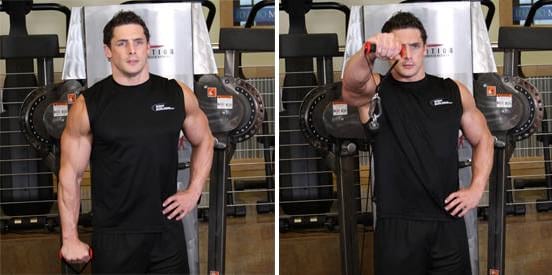Video Demonstration
This article will cover how you perform the Front Cable Raise exercise.
This article will include video, image and a written step by step description on how to do this exercise.
Its difficulty level, the equipment you need to do it. The different muscle groups that get worked when you use this exercise.
The benefits you get when adding it to your training routine. Also, some different training cues to use when you are performing it.
Front Cable Raise How to Guide
Image Example

Step by Step Description
Step 1: Select the weight you plan to use and put the single hand cable attachment on the low pulley machine. Use your left hand and grab the pulley hand attachment. Stand straight and face away from the pulley with your arm straight down beside your body. Have your hand in front of the left thigh. Use an overhand grip, so the palm of your hand is facing toward you.
You are now in the starting position.
Step 2: Keep your upper body stationary(do not let your body swing) Exhale and lift your left arm up in front of your (you palm should always be facing down). Continue raising your arm until it is just above parallel to the floor and pause.
Step 3: Inhale and slowly lower your arm back to the starting position. You need to use a slow and controlled movement.
Repeat for the desired number of reps and switch arms.
Difficulty Level
This strength training exercise gets rated at an intermediate difficulty level.
You should have spent some time training with the basic compound movements before moving on to this lift.
Equipment Required
For the variation, a cable machine gets used. If you do not have access to this piece of equipment, refer to the variations section below.
Muscles Worked
The Primary muscles that get worked by this lift are your Anterior Deltoid.
Multiple muscle groups work as synergists for this exercise. The primary synergists used are the Pecs and Trapezius.
Your Traps, Scapulae, obliques, abdominals and the Wrist Extensors are all used for stabilization.
Benefits From the Front Cable Raise
Improves your functional ability from lifting objects overhead or hauling boxes when you move strong shoulders give you the ability and strength to move them.
Strong shoulders also minimize your chance of strains when you perform overhead lifting.
Training Tips
You can keep your arms straight or have a slight bend in them while performing the movement.
It is common for people to try and power through the movement by bringing their lower back into the lift. Use a slow and controlled pace and focus on using your delts to lift the weight.
When you are in the top position for the exercise, pause and squeeze your delts for a second to fully activate the muscle.
Because of the mechanics used in this exercise, it is best to use a lighter weight in the 10 to 15 rep range. Using you max weight dramatically increases the chance of a rotator cuff injury.
Variations
This exercise can also be performed with a dumbbell, weight plate or kettlebell if you do not have access to a cable machine.
In Closing
If you have never tried this lift before or have been ignoring your lower body, try adding the Dumbbell Rear Lunge to your training routine for a couple of months to see for yourself all the benefits it has to offer.
Looking to gain more strength or lose some weight? We offer free fitness tools to help you reach your fitness goals. Register for free while we are in beta and get free lifetime access to our fitness tools that include an easy to use Calorie Counter, High-Intensity Interval Timer, Multiple Fitness Calculators and our Exercise Logger.